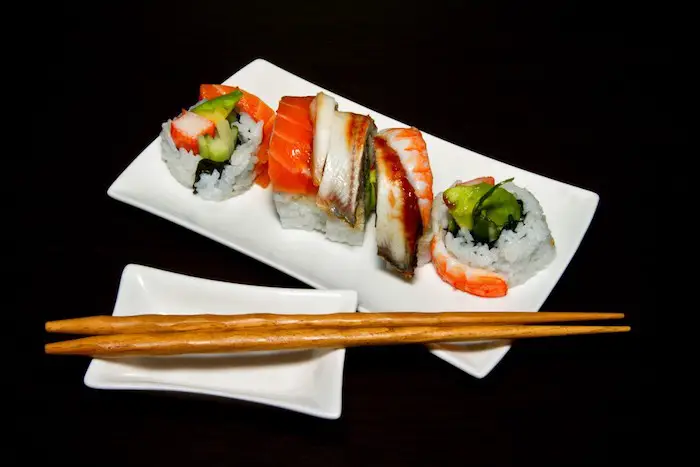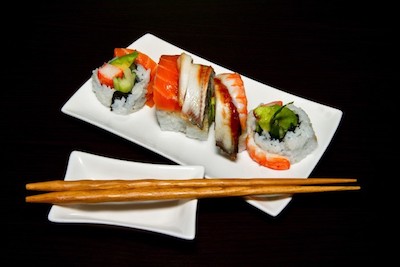We are reader supported. When you purchase through links on our site, we may earn an affiliate commission. Also, as an Amazon affiliate, we earn from qualifying purchases.

I have friends who love sushi so much that they look at it like a wild animal eyeing its prey. They leave no chance to enjoy a nigirizushi or maki roll whenever they can. It can be a bit nauseating to see someone push down so much of fish, nori, and rice down their gullet but they don’t seem to mind at all.
I often wonder – Can you eat sushi every day? I researched in-depth and found that Yes, you can. This Japanese delicacy involves a variety of other food such as veggies and fruits, instead of just raw fish or meat. Thus, you get different types of nutrients required by the body, while keeping the risks at bay.
Nevertheless, if you tell someone that you eat sushi every day, you are sure to get looks of disbelief. The reason behind this is that most people think only raw fish when they hear sushi. However, sushi is different from sashimi and there are several varieties that make this dish diversified.
Contents
Sushi Is A Rich Source Of Essential Nutrients
I am sure I don’t need to emphasize that our body requires essential nutrients to function properly. Raw fish (especially fatty fish like salmon) used in sushi is packed with omega-3 fatty acids that are known for supporting brain health and keeping heart diseases at bay.
While cooking or frying the fish reduces the advantages of omega-3 fatty acids, you can still get a lot of nutrients. The benefit of frying or steaming is that it reduces the risk of bacterial contamination. According to nutrition specialists, fish is also a rich source of protein, which makes it a great post-workout food to re-energize and speed up recovery.
If you are a vegan, you can still enjoy sushi filled with fillings like tofu, shitake mushrooms, semi-boiled spinach, semi-boiled carrots, cucumber, avocados, bell peppers, mangoes, and so on. Thus, your sushi roll can be a highly nutritious breakfast, lunch, or dinner.
The nutritional fact of sushi may vary widely depending on regional influences and how it is prepared. For example, western sushi restaurants may add an extra dose of Philadelphia cheese to traditional maki rolls, or they may swap white rice with brown rice or quinoa for the healthier alternative.
Making The Right Choice Is Important
According to health experts, it’s not just the food but the choices of sides and seasonings we use with the food make it good or bad. While a piece of salmon or tuna is healthy, it may not be the same if you bathe it in spicy sauces and creamy mayonnaise. This could add several hundred calories to your food.
Similarly, adding fried tempura to your sushi roll may not make it a healthy choice for breakfast every day. However, if you keep it light and eat a tuna cucumber roll or an avocado roll, it can be the perfect blend of nutrition and yummy flavors.
People Who Should Not Consume Raw Fish
No matter how much you love raw fish and seafood, you must avoid consuming or eat in moderation if you belong to these groups:
High-risk groups include individuals that have compromised immune systems, young children, and older people. They should avoid eating raw or undercooked fish.
Pregnant women should also avoid eating raw fish as they have a weakened immune system that can easily get infected and harm the fetus.
Breastfeeding and pregnant women should also avoid eating raw seafood due to high levels of mercury that may result in brain damage or hearing/ sight loss. Fish like swordfish, tuna, king mackerel, and shark should be avoided completely as they have high concentrations of mercury.
If you are pregnant and craving for sushi, you may eat it once in a week if not every day. The safest option is to cook your own sushi rolls at home. If you eat out, tell your chef to clean the knife properly to eliminate any risk of bacterial contamination.
Recommended Sushi Diet For Healthy Living
Every individual is different and there’s no fixed recommended intake for raw fish or seafood. However, the American Heart Association says 12 ounces of low-mercury raw fish per week is acceptable. If you include high-mercury fish in your diet, the intake should be less than 12 ounces.
The body cannot function well entirely on takeout sushi because it needs a varied diet to stay healthy. Hence, I recommend making your own sushi at home if you plan on consuming it every day. To find different ideas for fillings, read this article – 30 good ideas for sushi roll fillings.
Use different fillings such as fresh fruits, green vegetables, and other sources of lean proteins, healthy carbs and rich herbs. If you are wondering what are the different types of sushi you can eat, here are some of the tasty options:
Maki sushi rolls typically involved sushi rice wrapped in seaweed, with some fillings inside. They may be futomaki, uramaki , hosomaki, and shikai maki based on different ingredients. Read this article for more ideas and recipes – Maki sushi: All you need to know
Temaki is the hand rolled sushi shaped like a cone. It contains sushi rice, seaweed, and a variety of raw fish, seafood, vegetables, and fruits. Read this article – Sushi Hand roll Guide
Sashimi is not sushi, however, you may eat it when you want to give sushi rice and nori a miss. It includes a slice of raw fish or shellfish that is served on its own with wasabi and soy sauce.
Chirashi sushi is an interesting option when you want a filling lunch without bothering about rolling or shaping up the rice. It includes a bowl of seasoned sushi rice mixed with chopped vegetables, fish slices, and seasonings.
Related article: Chirashi vs Sashimi Detailed explanation
Nigiri is a piece of sashimi kept upon a bed of rice that is formed in an oval shape. The rice and raw fish is often held together with a strip of seaweed. Read this article for more information – Nigiri sushi all you need to know.
Inari sushi should not be eaten every day as it has a fried covering, however, this is a delicacy you may want to try once a week. To find the recipe to make fried tofu filled with seasoned sushi rice, read this article – What is inari sushi and how to make it a home.
Making Sushi At Home Everyday
With sushi becoming popular outside Japan, it is becoming easy to find anywhere you go. You may eat sushi at any Japanese sushi restaurant across the world, the takeaway from grocery stores or supermarkets, or make them at home.
The Asian grocery stores have all the ingredients needed to make your own sushi at home using raw fish, pickled vegetables, etc. If you vary the ingredients used in sushi, you may consume this delicacy every day if you wish.
Eating sushi every day could be a healthy choice if you maintain a perfect balance of vegetarian and seafood products. One sushi roll can contain as high as 500 calories. A California roll or spicy tuna roll may be about 200 to 300 calories. The vegetarian rolls such as cucumber maki or avocado rolls are usually less in calories.
According to Dietary Guidelines for Americans, an individual can consume about 8 to 12 ounces of raw fish and shellfish every week. So, you can balance it with vegetarian sushi to stay in limits and still enjoy your favorite delicacy daily.
What’s more? It is cheaper to make sushi at home than eating at a restaurant or ordering a takeaway. With the right ingredients at hand, you can make delicious sushi everyday and enjoy a filling meal with your family and friends. Read this article to find out why it is cheaper to make sushi at home.
Possible Downsides Of Eating Sushi Everyday
As mentioned above, you may eat sushi daily if you maintain a balanced diet. However, reckless eating may cause certain health issues. The biggest downside results from overeating fish containing high mercury levels.
It may cause temporary neurological problems in adults and other long-term damage in young children. I recommend using these low-mercury fish and seafood – light tuna, white fish pollock, shrimp, and salmon.
Another downside of eating sushi containing raw fish is the fear of microbial contamination from diseases causing bacteria such as Enterobacteriaceae, Aeromonas, Escherichia coli, and Staphylococcus. Try to avoid buying sushi from supermarkets or grocery stores as they could be sitting outside on the shelves for long.
Related Questions
What are the other fillings you may use instead of raw fish or seafood?
You may use cooked chicken or tamago as fillings to balance your sushi intake daily. To find out how to make tamago sushi at home, read this article – Tamago Sushi (or Tamagoyaki).
How much raw fish can a healthy adult consume?
A healthy adult can safely eat about 2-3 sushi rolls (10-15 pieces) containing raw fish or seafood per week.
What type of fish have higher levels of mercury?
Fish that are on the top of the food chain tend to have higher levels of mercury. The larger fish that eat smaller fish usually have more mercury in the flesh. Some examples are ahi tuna, sea bass, king mackerel, and swordfish.
What type of fish species are safe for pregnant and breastfeeding women?
Low-mercury fish include anchovies, hake, haddock, catfish, flounder, whitefish, pollock, mackerel, herring, salmon, trout, sardines, and butterfish.
What are the alternatives to seaweed (Nori)?
If you are tired of the same Nori in all your sushi, bring about a change of flavor by trying its substitutes. Some of the common substitutes for Nori are rice paper, cucumber wraps, tofu wrap, and collard greens. Find the recipes here – 7 Ways To Make Sushi Without Seaweed (Nori).
Are there other vegan options beside cucumber and avocado?
Yes, you may use pickled daikon radish, scallops, nato, peas and cashew nuts paste, etc. You can be creative and experiment with different types of fillings.

